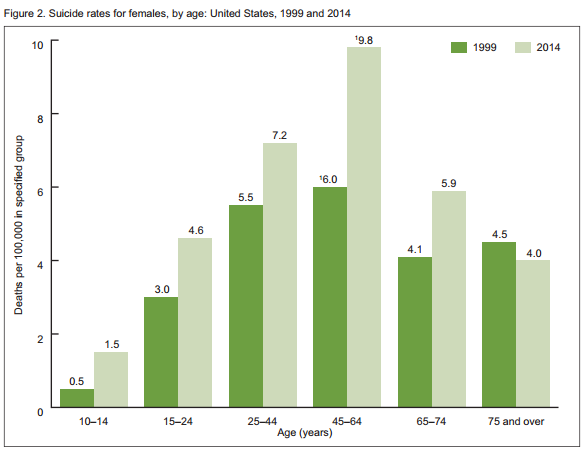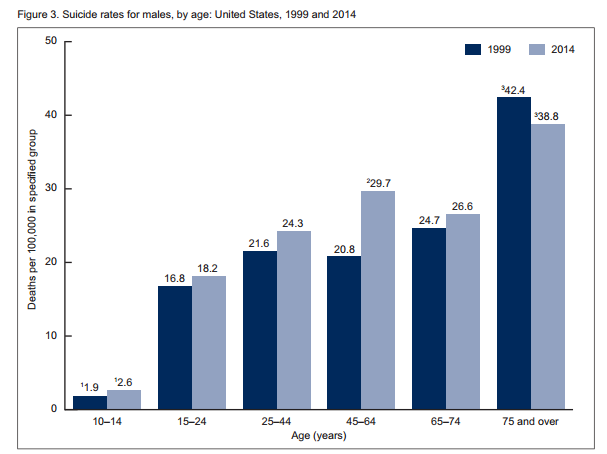Article
4 New Suicide Findings Pharmacists Should Know
Author(s):
Suicide rates in the United States declined from 1986 to 1999, but since then, they've been climbing somewhat steadily.
Suicide rates in the United States declined from 1986 to 1999, but since then, they’ve been climbing somewhat steadily.
Pharmacists’ frequent contact with patients may prove useful in detecting and preventing potential suicide attempts. Given that poisoning is one of the most common methods of suicide, pharmacists could play a role in preventing patients from obtaining the means to overdose on prescription medications.
The CDC’s National Center for Health Statistics recently released new data on suicide trends between 1999 and 2014. The deaths were categorized with ICD-10 codes for firearm, suffocation, poisoning, and other methods. The researchers were able to obtain demographic information from death certificates.
“Suicide is increasing against the backdrop of generally declining mortality and is currently 1 of the 10 leading causes of death overall and within each age group [from] 10 [to] 64 [years],” the researchers wrote.
Here are 4 things pharmacists should know about increasing suicide rates:
1. Suicide rates are increasing among all age groups, with the exception of those aged 75 years and older.
Suicide remains a leading cause of death among young adults and adolescents, and there have also been notable increases among middle-aged adults.
Girls aged 10 to 14 years saw the biggest increases in suicide rates. Among men, those aged 45 to 64 years saw the biggest increases.
One piece of good news from the CDC report was that the suicide rate for men and women aged 75 years and older is on the decline.
2. The largest annual percent increases in suicide rates were seen after 2006.
The annual percent increase in age-adjusted suicide rates was around 1% per year from 1999 to 2006, but it increased to 2% per year starting in 2006.
The age-adjusted rate in 2014 was 13 suicides per 100,000 individuals, which was 24% higher than the rate in 1999.
3. Women have lower suicide rates than men, but that gender gap is narrowing.
The age-adjusted rate for men who committed suicide in 2014 (20.7) was more than 3 times the rate for women (5.8).
However, the percent increase in suicide was higher for women than men from 1999 through 2014. The age-adjusted suicide rate for women increased 45% in that time period, while the age-adjusted rate for men increased 16%.
Among all the female age groups, women aged 45 to 64 years had the second-largest percent increase (63%) in suicides since 1999. The largest percent increase (200%) was for girls aged 10 to 14 years, but the researchers said this was based on a small number of suicides compared with other age groups.
The percent increases for women aged 15 to 24 years, 25 to 44 years, and 65 to 74 years ranged between 31% and 53%.

CDC
Among all male age groups, those aged 75 years and older continued to have the highest suicide rates from 1999 through 2014, although it declined by 8% in that time period. Men aged 45 to 64 years had the second-highest suicide rate in 2014, and this group saw the largest percent increase (43%).
Men aged 10 to 14 years had the lowest suicide rate compared with the other male age groups, but the researchers noted that this group had the second-largest percent increase (37%) from 1999 to 2014.

CDC
4. Suicides by firearms and poisoning are decreasing, but suicides by suffocation are increasing.
Around 1 in 4 suicides in 2014 resulted from suffocation, which includes hanging and strangulation. Back in 1999, suffocation was used in fewer than 1 in 5 suicide cases.
Still, poisoning was the most common method of suicide for women in 2014. A little more than one-third of women who committed suicide did so through poisoning. In 1999, the most common way women committed suicide was by firearm.
In contrast, 55% of suicides among men in 2014 involved firearms, but this was a drop from 61.7% in 1999.
The most frequent “other” forms of suicide involved falls or drowning for women and falls or cutting/piercing for men.





